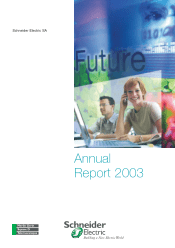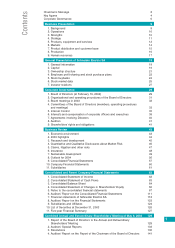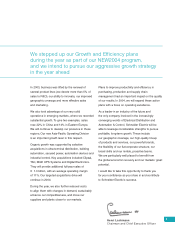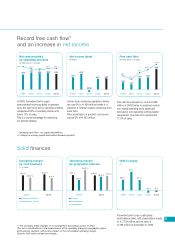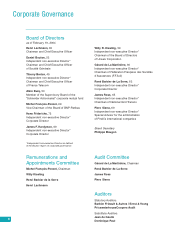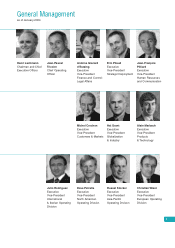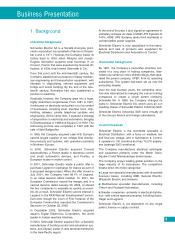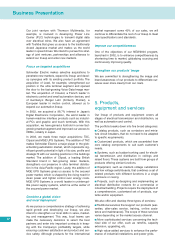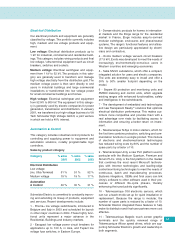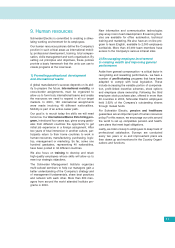APC 2003 Annual Report Download - page 11
Download and view the complete annual report
Please find page 11 of the 2003 APC annual report below. You can navigate through the pages in the report by either clicking on the pages listed below, or by using the keyword search tool below to find specific information within the annual report.
1. Background
Industrial background
Schneider Electric SA is a Société Anonyme (joint-
stock corporation) incorporated in France on Decem-
ber 2 and 4, 1871. However, the Company traces its
history back to 1836, when Adolphe and Joseph-
Eugène Schneider acquired steel foundries in Le
Creusot, France that were experiencing financial dif-
ficulties. In 1838, they formed Schneider & Cie.
From that point until the mid-twentieth century, the
Company steadily built a presence in heavy mechan-
ical engineering and transportation equipment, with
interests in shipbuilding, railroad equipment and
bridge and tunnel building. By the end of the nine-
teenth century, Schneider had also established a
position in electricity.
Gradually, however, the Company grew into a huge,
highly diversified conglomerate. From 1981 to 1997,
it refocused on electricity and pulled out of a number
of businesses, including steel, machine tools, ship-
building, railways, private telephone systems and
engineering. At the same time, it pursued a strategy
of acquisitions in electricity and automation, bringing
in Telemecanique in 1988 and Square D in 1991. The
refocusing process was completed in 1997 with the
sale of Spie Batignolles.
In 1999, the Company acquired Lexel A/S, Europe’s
second largest supplier of low voltage final distribu-
tion products and systems, with operations primarily
in Northern Europe.
In 2000, Schneider Electric acquired Crouzet
Automatismes, a French leader in electronic control
and small automation devices, and Positec, a
European leader in motion control.
In 2001, Schneider Electric made a public offer to
purchase Legrand in exchange for shares as part of
a proposed merger project. When the offer closed in
July 2001, the Company held 98.1% of Legrand.
In an initial decision dated October 10, 2001, the
European Commission vetoed the merger, and in a
second decision dated January 30, 2002, it ordered
the two companies to separate as quickly as possi-
ble. As a result, Schneider Electric sold its interest in
Legrand to the KKR-Wendel Investissement consor-
tium even though the Court of First Instance of the
European Communities overruled the Commission’s
decisions on October 22, 2002.
In December 2002, Schneider Electric acquired
Japan’s Digital Electronics Corporation, the world
leader in human-machine interface.
In 2003, Schneider Electric acquired TAC, a Swedish
manufacturer of building control and automation sys-
tems, and Clipsal, leader in ultra terminal distribution
in the Asia-Pacific region.
At the end of the year, it also signed an agreement to
ultimately increase its stake in MGE UPS Systems to
100%. MGE UPS Systems ranks third worldwide in
uninterruptible power supplies.
Schneider Electric is now specialized in the manu-
facture and sale of products and equipment for
Electrical Distribution and Automation & Control.
Ownership background
By 1981, the Company’s ownership structure con-
sisted of a long chain of holding companies, inter-
locked via numerous cross-shareholdings, that sepa-
rated the parent company, SPEP, from its operating
subsidiaries. This system had been set up over the
preceding decade.
Over the next fourteen years, the ownership struc-
ture was rationalized by merging the various holding
companies to create a single parent company,
Schneider SA. In 1999, the Company changed its
name to Schneider Electric SA, which owns all out-
standing shares of Schneider Electric Industries SAS.
Schneider Electric Industries SAS owns virtually all
of the Group’s French and foreign subsidiaries.
Current business
Schneider Electric is the worldwide specialist in
Electrical Distribution, with a focus on medium, low
and final low voltage, and in Automation & Control.
It operates in 130 countries and has 74,276 employ-
ees (average 2003 workforce).
The Company manufactures electrical switchgear
and equipment primarily under the Merlin Gerin,
Square D and Telemecanique brand names.
The Company enjoys leading global positions in the
large majority of its businesses. The competition
breaks down into three categories:
■Large non-specialist manufacturers with diversified
business bases, including ABB, General Electric,
Mitsubishi Electric and Siemens.
■Multinational specialist manufacturers, including
Omron and Rockwell Automation.
■Smaller companies –primarily in electrical distribu-
tion– with a more regional presence, including Eaton,
Hager and Legrand.
Schneider Electric is not dependent on any single
patent, license or supply contract.
Business Presentation
9

